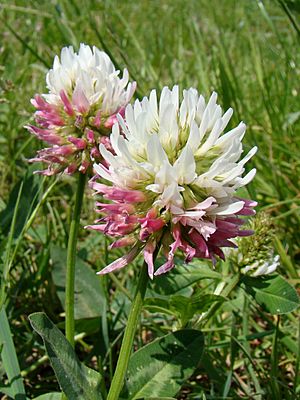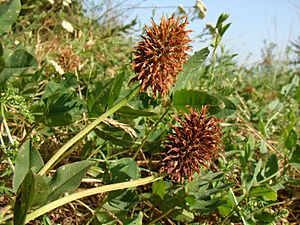Kura clover facts for kids
Trifolium ambiguum, also known as kura clover or Caucasian clover, is a type of flowering plant. It belongs to the pea family, which includes many plants like peas, beans, and lentils. This plant is originally from areas like Ukraine, Crimea, parts of southern Russia, the North Caucasus, Turkey, Iraq, and Iran. It has also been brought to places like New South Wales in Australia. People often plant kura clover to feed animals, and it's also great for bees to make honey!
Quick facts for kids Kura clover |
|
|---|---|
 |
|
| Flowers | |
 |
|
| Seed pods | |
| Scientific classification | |
| Genus: |
Trifolium
|
| Species: |
ambiguum
|
| Synonyms | |
|
|
Contents
Discovering Kura Clover: A Special Plant
Kura clover is a green plant with pretty flowers. These flowers are often white or pinkish, and they grow in small, round clusters. After the flowers, the plant produces small seed pods. These pods hold the seeds that will grow into new kura clover plants.
Where Does Kura Clover Grow?
This plant naturally grows in many parts of Eastern Europe and Western Asia. You can find it in countries like Ukraine and Russia. It also grows in the mountainous region of the North Caucasus. Further south, it is native to Turkey, Iraq, and Iran. Over time, people have moved kura clover to other places. For example, it now grows in New South Wales, Australia.
Why is Kura Clover Important?
Kura clover is very useful for several reasons. One main reason is that it makes excellent food for animals. Farmers often plant it in fields where animals like cows or sheep graze. This plant can handle being eaten often and still grow back strong. This makes it a great choice for animal feed.
Kura Clover and Honey Bees
Another important use for kura clover is in making honey. Bees love the flowers of this plant. They collect nectar from the blooms to produce delicious honey. This helps beekeepers and supports the bee population. Bees are very important for pollinating many other plants too.

